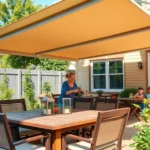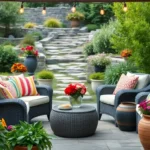We’ve all dreamed of having our own personal retreat right in our backyard – a place where we can escape daily stress and reconnect with nature. Outdoor saunas are becoming the ultimate wellness trend that transforms any outdoor space into a luxurious spa experience.
Whether you’re working with a sprawling estate or a cozy patio, there’s an outdoor sauna solution that’ll fit your space and budget perfectly. From sleek modern designs that complement contemporary homes to rustic barrel saunas that blend seamlessly with natural landscapes, the possibilities are endless.
We’ll explore innovative ideas that go beyond traditional sauna concepts, including DIY options, eco-friendly materials, and smart integration with existing outdoor features. Ready to discover how you can create your own backyard oasis that’ll become the envy of your neighborhood?
Traditional Finnish Log Sauna Designs
Finnish sauna traditions offer timeless design principles that bring authentic warmth and character to outdoor spaces. These classic designs emphasize natural materials and proven construction techniques that have withstood centuries of use.
Classic Cedar Construction Methods
Full log construction creates the most authentic Finnish sauna experience using interlocking horizontal logs. We recommend selecting logs with a minimum 6-inch diameter for optimal thermal mass and structural integrity. The traditional Finnish method requires careful attention to corner joinery, where each log fits precisely into notched cuts.
Chinking techniques fill gaps between logs using natural materials like moss, clay, or modern synthetic alternatives. Quality chinking prevents heat loss while allowing the wood to expand and contract with seasonal changes. We’ve found that leaving small ventilation gaps near the ceiling helps maintain proper airflow.
Foundation requirements for log saunas include concrete piers or a full concrete pad that elevates the structure 6-12 inches above ground level. This elevation protects the bottom logs from moisture damage and extends the sauna’s lifespan significantly.
Authentic Wood-Burning Stove Options
Traditional Finnish wood stoves like Harvia or Helo models provide the authentic löyly steam experience that electric heaters can’t replicate. These stoves feature large rock chambers that hold 40-60 pounds of sauna stones for optimal heat retention and steam production.
Chimney placement through the roof creates the most efficient heat distribution and follows traditional Finnish design principles. We recommend installing the chimney directly above the stove with proper clearances: 18 inches from combustible walls and 2 inches from the ceiling.
Firewood storage integrates beautifully into log sauna designs with built-in compartments beneath the stove platform. These storage areas keep seasoned hardwoods like birch or oak dry and easily accessible during sauna sessions.
Traditional Benching and Layout Configurations
Two-tier bench systems maximize seating while following authentic Finnish proportions with the upper bench 18-19 inches deep and lower bench 12-14 inches deep. Traditional spacing places the upper bench 42-48 inches from the floor and the lower bench 18-24 inches high.
L-shaped configurations work best in rectangular saunas, positioning benches along two adjacent walls to accommodate 4-6 people comfortably. This layout keeps all users within the optimal heat zone while maintaining clear pathways to the door.
Nordic pine or aspen benching remains the gold standard for traditional saunas because these woods stay cooler to the touch and resist moisture damage. We space bench slats 1/2 inch apart for proper drainage and air circulation, ensuring comfort during extended sauna sessions.
Modern Minimalist Outdoor Sauna Concepts

We’re seeing outdoor saunas evolve into sophisticated wellness spaces that embrace clean lines and functional simplicity. Contemporary designs draw inspiration from Scandinavian and Japanese aesthetics to create uncluttered retreats that enhance your connection to nature.
Sleek Contemporary Materials and Finishes
Thermowood stands out as our top choice for exterior cladding because it offers exceptional durability and rich texture. We recommend wire brushing and finishing with natural oils to achieve that sophisticated look that modern homeowners crave. Black or natural wood finishes maintain an understated appearance that complements any industry design.
Interior spaces benefit from warm thermo aspen or spruce paneling that creates a calming contrast to the sleek exterior. Concrete look porcelain tiles add contemporary appeal while providing durability and easy maintenance for high moisture areas. Natural sheep’s wool insulation paired with slow grown larch vapor cavities efficiently manages moisture and ventilation to ensure your sauna’s longevity.
Electric Heating System Integration
Electric stoves have become the preferred heating method for modern outdoor saunas due to their ease of use and clean operation. We appreciate how these systems allow precise temperature control and quick heating for saunas accommodating 2 to 6 people. Many models offer customizable heaters with various casings and finishes that maintain design harmony with your minimalist aesthetic.
Installation proves straightforward compared to traditional wood burning options, making electric systems ideal for contemporary outdoor settings. Temperature consistency ensures optimal sauna experiences without the maintenance requirements of wood fired alternatives.
Glass Wall and Window Design Elements
Large edge to edge double glazed windows create an intimate connection with surrounding nature while maintaining privacy through optional frosted glass options. Expansive glass fronts flood interiors with natural light and allow panoramic outdoor views that enhance the minimalist experience. We’ve found that these design elements transform small sauna spaces into open, airy retreats.
Privacy glass combined with adjustable LED lighting integrated behind backrests creates ambiance for both day and evening sessions. Some designs incorporate full glass walls that blur the boundaries between indoor comfort and outdoor beauty, making your sauna feel like a natural extension of your industry.
DIY Barrel Sauna Construction Ideas

Building a barrel sauna yourself offers the ultimate customization opportunity while creating a stunning focal point for your outdoor space. We’ll explore three distinct approaches that cater to different skill levels and project goals.
Pre-Fabricated Barrel Sauna Kits
Pre-fabricated kits transform complex barrel sauna construction into a manageable weekend project. These comprehensive packages include pre-cut staves, doors, benches, windows, and heating units with detailed assembly instructions that simplify the building process.
Most kits feature a standard 6-foot diameter design with adjustable length options ranging from 6 to 12 feet, allowing you to customize the sauna size based on your available space. The pre-cut materials eliminate the need for specialized woodworking tools like router tables and cove router bits, making barrel sauna ownership accessible to DIY enthusiasts with basic construction skills.
Assembly typically requires 2-3 people and can be completed in 1-2 days, depending on the kit size and your experience level. Quality kits include cedar or other rot-resistant materials, ensuring your investment provides years of reliable service with minimal maintenance requirements.
Custom Barrel Building Techniques
Custom barrel construction demands advanced woodworking skills but delivers unmatched personalization options. We start by milling curved edges on wooden staves using cove router bits, creating the precise bead and cove joints that form the barrel’s characteristic shape.
The fundamental technique involves cutting grooves in each stave to fit securely onto the gable ends, requiring templates or jigs for precision cuts. Laying out wood in circular patterns becomes crucial for maintaining the barrel’s structural integrity and achieving the tight water-resistant seal essential for proper sauna function.
Material choices expand significantly with custom builds, allowing selection between cedar, redwood, or other premium woods based on your climate and aesthetic preferences. Heating options include both traditional wood-fired stoves and modern electric units, with each requiring exact ventilation and safety considerations during the design phase.
Advanced builders often incorporate unique features like custom window placements, specialized bench configurations, and exterior finishing techniques that complement existing industry elements. Building larger barrels on-site eliminates transportation challenges while enabling dimensions that exceed standard kit limitations.
Space-Saving Installation Benefits
Barrel saunas maximize outdoor space efficiency through their inherently compact circular design that requires minimal ground footprint. The cylindrical shape allows heat to circulate evenly while occupying significantly less area than traditional rectangular sauna designs.
This rounded form reduces material requirements relative to interior volume, resulting in lower construction costs and faster heating times that improve energy efficiency. Heat distribution becomes naturally optimized as the curved walls eliminate corners where cold air typically accumulates in conventional saunas.
Installation flexibility makes barrel saunas ideal for challenging spaces like narrow side yards, sloped terrain, or areas with existing landscaping constraints. The self-supporting barrel structure often requires only a simple gravel pad or concrete foundation, reducing site preparation compared to traditional sauna buildings.
Transportation advantages emerge when choosing pre-fabricated options, as the curved sections typically fit on standard trailers and can navigate tight access routes that would prevent delivery of larger rectangular units. Quick setup times mean you can enjoy your new sauna within days rather than weeks, making barrel designs perfect for seasonal installation or temporary placement scenarios.
Infrared Outdoor Sauna Solutions

Moving beyond traditional heating methods, infrared outdoor saunas offer cutting edge technology that delivers therapeutic benefits with remarkable efficiency. These systems represent a important advancement in outdoor wellness design, combining modern innovation with practical outdoor functionality.
Carbon Fiber Heating Panel Systems
Carbon fiber heating panels revolutionize the outdoor sauna experience by emitting far infrared waves that penetrate deep into the body. These panels heat users directly rather than warming the surrounding air, creating a gentle therapeutic session that’s particularly effective in variable outdoor conditions. Unlike traditional wood burning or electric systems, carbon fiber technology delivers consistent heat distribution while consuming significantly less energy.
Far infrared waves produced by these panels provide therapeutic benefits including improved circulation, muscle relaxation, and enhanced detoxification. We’ve observed that carbon fiber panels maintain optimal performance even when outdoor temperatures fluctuate dramatically. Installation flexibility allows us to position these panels strategically throughout the sauna interior, ensuring every user enjoys even heat coverage regardless of seating position.
Weather-Resistant Infrared Technology
Robust exterior cladding protects infrared heating systems from harsh outdoor elements including rain, snow, and extreme temperature changes. Manufacturers now engineer these saunas with protective finishes that withstand UV exposure, moisture infiltration, and seasonal temperature variations without compromising performance. Sealed electrical components ensure safe operation in all weather conditions, making these units suitable for installation in gardens, lakeside locations, or forest settings.
Protective construction methods include reinforced housing materials, weatherproof electrical connections, and corrosion resistant hardware that maintains functionality year round. These durability features allow us to enjoy consistent sauna sessions regardless of external weather patterns. Advanced sealing techniques prevent moisture damage while maintaining the structural integrity needed for long term outdoor installation.
Energy-Efficient Operation Features
Smart temperature and humidity controls optimize energy consumption while delivering precise environmental management for outdoor infrared saunas. Programmable timers allow us to schedule heating cycles during off peak energy hours, reducing operational costs while ensuring the sauna reaches optimal temperature when needed. App based remote management systems enable monitoring and adjustment from anywhere, maximizing convenience and energy efficiency.
Solar connectivity options and ultra low wattage settings further reduce electricity consumption, making these systems environmentally responsible choices for eco conscious homeowners. Modular designs allow customization of size, finish, and heater configuration to match exact energy requirements and outdoor space constraints. These efficiency features combine to create sustainable wellness answers that minimize environmental impact while maximizing user satisfaction.
Container and Shipping Crate Sauna Conversions
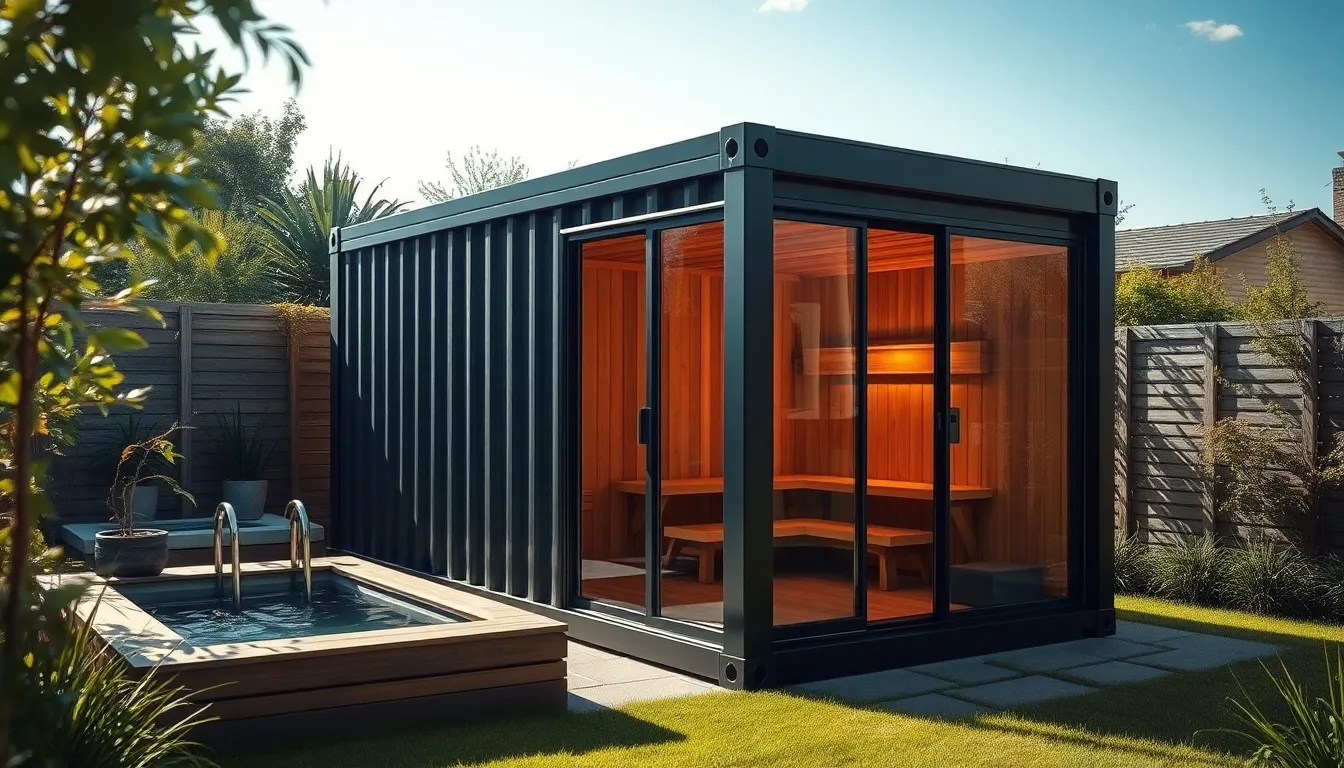
We’re seeing shipping containers emerge as one of the most innovative answers for outdoor sauna construction. These steel structures offer durability and modularity that traditional building methods can’t always match.
Repurposed Shipping Container Modifications
Standard 20ft containers accommodate 4–6 people comfortably while 40ft units expand capacity to 12 occupants for larger gatherings. Installing heat and moisture barriers transforms the metal shell into an efficient sauna room that retains warmth effectively. We recommend adding windows and doors specifically designed for heat retention alongside proper ventilation systems.
Interior modifications include wood paneling installation, custom bench construction, and stove or electric heater placement for optimal heat distribution. Waterproofing and sealing prevent moisture damage while maintaining the sauna’s heat retention capabilities. Creative designs now combine saunas with cold plunge pools or hot tubs within the same container structure, maximizing wellness benefits in compact spaces.
Rust protection and weather shielding treatments are essential to prevent corrosion and extend the container’s lifespan outdoors. These protective measures ensure your investment remains functional and attractive for years of outdoor sauna enjoyment.
Insulation and Ventilation Requirements
Insulation layers ranging from 5 to 10 cm thick maintain heat efficiently while blocking external cold temperatures effectively. Proper insulation enables your sauna to retain warmth for at least 30 minutes after turning off the heater, ensuring extended relaxation sessions.
Ventilation systems balance heat retention with fresh air supply through strategic vent placement near floor and ceiling levels. Natural convection flows develop when vents are positioned correctly, promoting air circulation without compromising temperature control. We emphasize the importance of moisture control through proper ventilation to prevent condensation buildup and maintain air quality.
Safety considerations require adequate airflow to ensure comfortable breathing conditions throughout your sauna session. Balanced ventilation systems protect both the structure and users while maintaining optimal sauna performance.
Industrial Aesthetic Design Approaches
The raw, rugged texture of shipping containers provides an industrial aesthetic that complements modern outdoor design trends perfectly. Exposed metal surfaces with minimal treatment create striking visual contrast against surrounding industry elements.
Contrasting warm wood interiors against cool steel exteriors enhances the industrial vibe while providing comfortable sauna environments. Minimalist, functional design elements emphasize the container’s utilitarian origins while serving practical sauna needs. Black or metallic finishes accentuate the industrial appearance and create sophisticated outdoor wellness spaces.
Exterior treatments range from maintaining the original container look to adding wood slats or artistic paintwork for visual warmth and uniqueness. These design choices allow customization while preserving the industrial character that makes container saunas distinctive additions to backyard or commercial wellness settings.
Luxury Outdoor Sauna Features and Amenities

Elevating your outdoor sauna experience requires thoughtful selection of premium amenities that blend functionality with sophisticated design. These high-end features transform a simple heat therapy session into a comprehensive wellness retreat.
Premium Wood Species Selection
Thermally modified lumber stands as the gold standard for luxury outdoor sauna construction, offering unmatched durability and resistance to outdoor elements. This advanced treatment process enhances wood stability while maintaining natural beauty and performance characteristics.
Cedar varieties deliver exceptional moisture resistance and natural aromatherapy benefits through their distinctive fragrance during heating cycles. Western Red Cedar and Northern White Cedar remain popular choices among luxury sauna builders for their proven longevity in outdoor environments.
Sustainably sourced hemlock provides an eco-conscious option that combines affordability with reliable performance in outdoor applications. Premium hemlock selections offer tight grain patterns and consistent color matching that enhance the overall aesthetic appeal of luxury installations.
Exotic wood options like Finnish spruce or Norwegian pine create authentic Nordic experiences while providing superior heat retention properties. These premium species often feature unique grain patterns and natural oils that contribute to the sauna’s therapeutic atmosphere.
Integrated Sound and Lighting Systems
Bluetooth stereo integration allows seamless wireless connectivity for personalized audio experiences during sauna sessions. Professional-grade outdoor speakers resist moisture and heat while delivering crystal-clear sound quality that enhances relaxation.
Chromotherapy lighting systems use color psychology to promote exact wellness benefits through carefully programmed light sequences. Red wavelengths can stimulate circulation while blue tones encourage deep relaxation and stress reduction.
Customizable LED lighting offers infinite color combinations and dimming capabilities that adapt to different times of day and personal preferences. Smart control systems allow users to create preset lighting scenes for morning energization or evening wind-down sessions.
Cutting-edge automation connects lighting and sound systems through centralized control panels or smartphone applications. Users can program synchronized audio-visual experiences that automatically adjust throughout their sauna session.
Adjacent Cold Plunge Pool Options
Temperature contrast therapy maximizes health benefits by alternating between sauna heat and cold water immersion for improved circulation and recovery. Professional athletes and wellness enthusiasts increasingly recognize this combination as essential for optimal therapeutic results.
Integrated pool designs seamlessly blend with sauna architecture through matching materials and complementary styling that creates cohesive outdoor wellness environments. Strategic placement ensures easy transition between hot and cold experiences while maintaining privacy and comfort.
Chilled water systems maintain consistent cold temperatures through advanced refrigeration technology that operates efficiently in outdoor conditions. Automated filtration and sanitization systems ensure water quality meets health standards for regular use.
Multi-user configurations accommodate simultaneous sauna and cold plunge usage for couples or families pursuing wellness activities together. Separate entry points and adequate space planning prevent overcrowding while maximizing the luxury experience for all participants.
Budget-Friendly Outdoor Sauna Alternatives
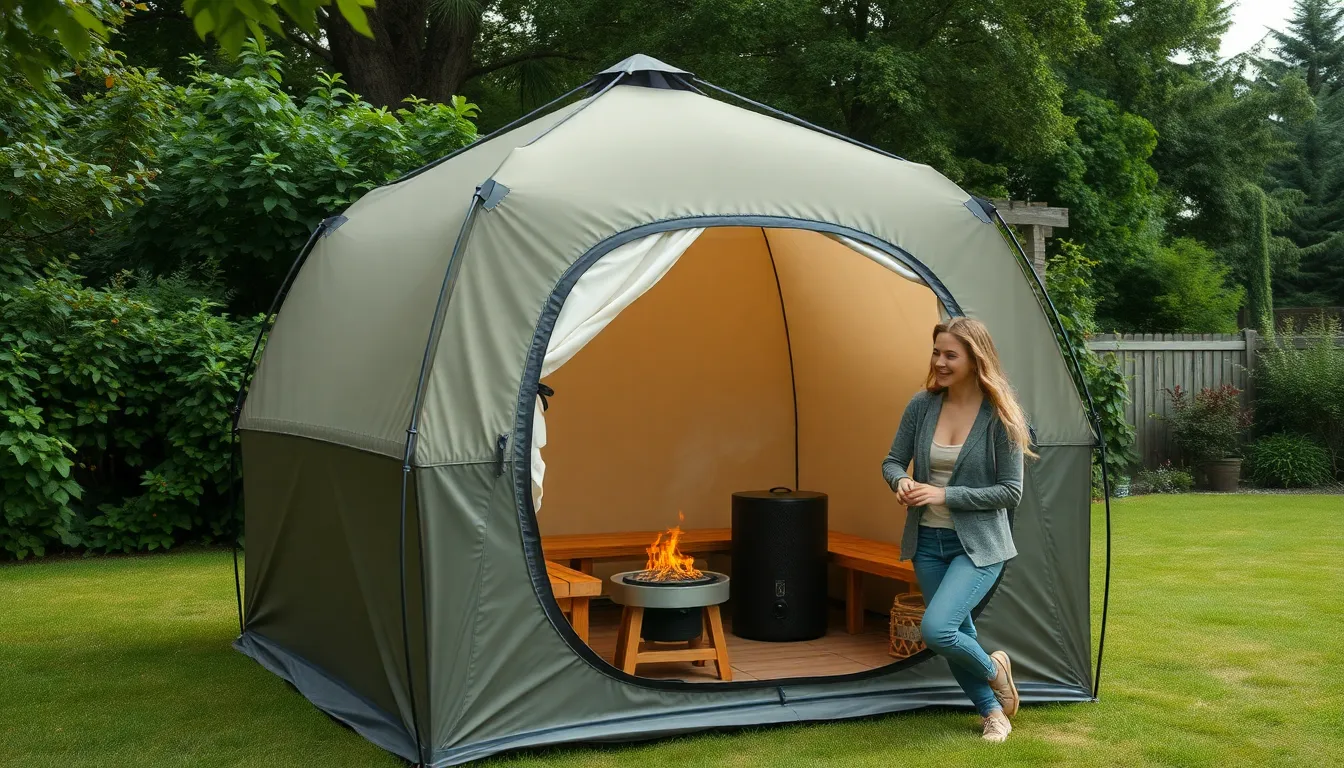
Creating your dream outdoor sauna doesn’t require a massive investment. We’ve explored several affordable options that deliver authentic sauna experiences without breaking your budget.
Portable Sauna Tent Answers
Portable sauna tents offer the most affordable entry point into outdoor sauna ownership, with many models starting under $200. Canvas and nylon construction materials provide excellent durability while maintaining lightweight portability for easy setup in different locations.
Electric sauna heaters pair perfectly with these tents, allowing you to achieve optimal temperatures between 140-180°F in minutes. Most portable units accommodate 1-2 people comfortably and pack down to the size of a large camping tent.
Inflatable sauna tents represent the cutting edge of portable sauna technology, featuring rapid setup times under 10 minutes. Air chamber construction creates superior insulation compared to traditional tent materials, while integrated heating systems eliminate the need for separate equipment.
Sauna bags provide the ultimate in personal sauna experiences, weighing just 3-5 pounds when packed. Compact design allows you to transform any outdoor space into a private wellness retreat using nothing more than a portable heater and your preferred location.
Simple Shed Conversion Projects
Converting existing sheds into functional saunas typically costs 60-70% less than building from scratch. Small garden houses measuring 6×8 feet provide ideal dimensions for 2-4 person sauna capacity with proper bench configuration.
Thermal insulation forms the foundation of successful shed conversions, with foam board or fiberglass materials offering cost effective heat retention. R-13 to R-15 insulation values ensure optimal temperature maintenance while keeping material costs under $300 for average sized conversions.
Electric heater installation simplifies the conversion process compared to wood burning alternatives, with 240V units providing reliable temperature control. Gas heaters offer another budget friendly option, particularly in areas with lower electricity costs or existing propane infrastructure.
Interior design elements like cedar or pine cladding create authentic sauna aesthetics at fraction of premium wood costs. Reclaimed materials from renovation projects often provide unique character while reducing expenses by 40-50% compared to new lumber purchases.
Cost-Effective Material Substitutions
Reclaimed wood delivers exceptional value for sauna cladding projects, offering weathered character that new materials can’t replicate. Barn wood, fence posts, and demolished building materials frequently cost 30-60% less than retail lumber while providing superior aging and grain patterns.
Affordable insulation alternatives include recycled denim, sheep’s wool, and foam board systems that perform comparably to expensive specialty products. Fiberglass batts remain the most budget conscious choice, providing R-values of 11-15 per inch at costs under $1 per square foot.
Sustainable materials like bamboo flooring and recycled composite decking offer moisture resistance and longevity without premium price tags. These eco friendly options frequently cost 20-30% less than traditional cedar while requiring minimal maintenance over their lifespan.
Alternative heating answers include wood pellet stoves, propane units, and electric baseboard heaters that cost significantly less than specialized sauna equipment. Creative installations using automotive radiators, solar collectors, or rocket mass heaters can reduce heating costs by 80% while maintaining effective temperature ranges.
Seasonal and Climate Considerations
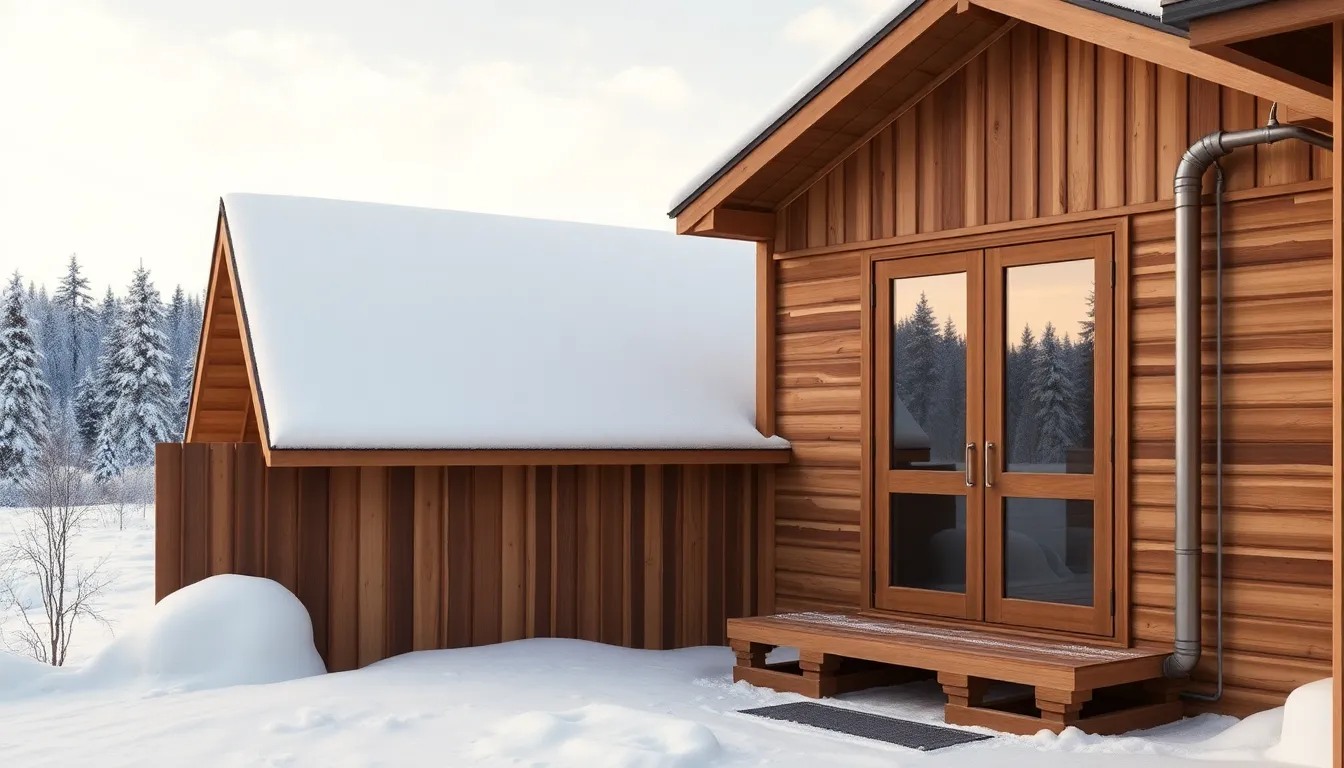
Climate directly impacts every aspect of your outdoor sauna’s performance and longevity. We’ll guide you through essential strategies for protecting your investment while maximizing comfort throughout all seasons.
Winter Weather Protection Strategies
Insulation becomes your sauna’s best defense against freezing temperatures that can compromise heat retention and structural integrity. We recommend installing high-quality insulation in walls, floors, and ceilings to maintain consistent interior temperatures even when outdoor conditions drop below freezing.
Heating systems designed for cold climates ensure your sauna reaches optimal temperatures efficiently. Wood-fired heaters and electric units specifically rated for harsh winter conditions provide reliable performance when temperatures plummet.
Weatherproof materials protect against snow and moisture damage that can devastate unprotected structures. Cedar and larch exterior cladding withstand winter weather while maintaining their natural beauty and structural strength.
Protective roofing and terraces prevent snow accumulation around entry points and high-traffic areas. Overhangs create sheltered entrances while reducing ice formation that could create safety hazards.
Proper drainage systems prevent water and ice buildup around your sauna’s foundation. We’ve seen countless structures compromised by poor drainage that allows moisture to freeze and expand against foundation walls.
Double-glazed glass maintains heat while preserving views of your winter industry. Insulated windows and doors create thermal barriers without sacrificing the outdoor connection that makes your sauna special.
Summer Ventilation and Cooling Methods
Adjustable vents provide crucial airflow control during hot summer months when overheating becomes a primary concern. Windows and vents that open and close allow you to regulate interior temperatures based on outdoor conditions.
Strategic shading keeps your sauna comfortable when summer sun would otherwise make it unbearable. Trees, pergolas, and other shade structures reduce heat buildup while creating attractive outdoor spaces.
Natural wood construction breathes better than synthetic materials, helping regulate temperature through natural air circulation. Cedar and other breathing woods naturally cool more effectively than metal or composite alternatives.
Outdoor lounge areas encourage post-sauna relaxation in shaded comfort zones adjacent to your main structure. Terraces and decks extend your wellness experience beyond the sauna itself.
Solar-powered ventilation offers eco-friendly cooling without increasing your electricity costs. Solar fans enhance airflow automatically when sun exposure is highest, providing natural temperature regulation.
Year-Round Maintenance Requirements
Regular cleaning prevents mold and mildew that thrive in moisture-rich environments typical of sauna structures. We recommend monthly deep cleaning of interior and exterior surfaces to maintain optimal hygiene standards.
Annual wood treatment protects against UV damage and moisture that can compromise structural integrity over time. Weather-resistant sealants applied yearly extend the life of exterior wood surfaces significantly.
Seasonal heater inspections maintain safety and efficiency throughout your sauna’s operational life. Flues, electrical systems, and heating units require professional checks to prevent dangerous malfunctions.
Drainage maintenance keeps water moving away from your foundation and surrounding areas. Clear drainage systems year-round prevent costly water damage and structural problems.
Winterizing protects vulnerable components during extreme cold periods when usage may be minimal. Plumbing and water features require draining or insulating to prevent freeze damage.
Routine vent checks ensure proper airflow adjustment as seasonal conditions change throughout the year. Functioning vents and windows allow you to optimize comfort regardless of weather conditions.
Location and Placement Planning
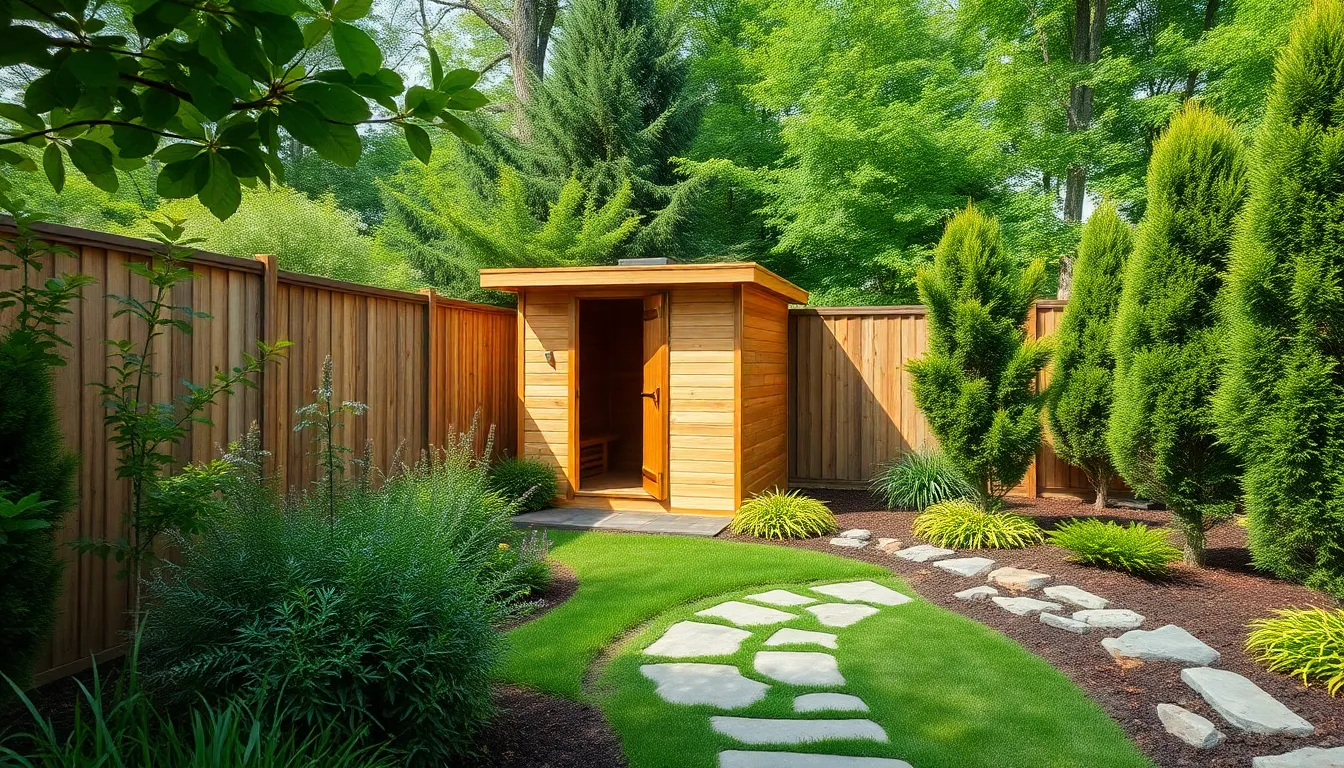
Strategic location selection forms the foundation of successful outdoor sauna placement. We’ll explore three critical considerations that ensure your sauna becomes a functional and enjoyable retreat.
Privacy and Landscaping Integration
Privacy creates the essential foundation for a truly relaxing sauna experience. We recommend using tall fences, lattice panels, or bamboo screens that blend seamlessly with garden and sauna aesthetics for immediate screening. Fast-growing evergreens like arborvitae or dense shrubbery provide natural privacy barriers and year-round coverage that evolves with your industry.
Integrating perennial shrubs, tall grasses, and trees with large canopies adds texture and color while delivering additional shade and seclusion. Wooden pathways and natural stone accents can lead to your sauna, reinforcing a rustic, nature-inspired environment that feels connected to the outdoors. Sustainable landscaping practices, including native plants and rainwater collection, further harmonize the sauna with its surroundings.
Location selection should balance natural beauty, privacy, and convenience by placing your sauna in a quiet corner of your yard. Consider positioning it shielded by a house, garage, or natural landform while maintaining easy access from your home. Proximity to trees, gardens, or water features enhances the ambiance and creates a more immersive wellness experience.
Electrical and Plumbing Access Points
Electrical infrastructure requirements demand careful consideration during the planning phase. Outdoor saunas require dedicated electrical circuits for heaters and lighting systems that meet local electrical codes. We recommend selecting sites that allow for straightforward electrical hookup to minimize installation complexity and costs.
Plumbing connections become essential if your sauna design includes showers or water features. Proximity to existing plumbing lines reduces installation complexity and associated expenses significantly. Planning for both utilities during the initial site selection prevents costly modifications later in the construction process.
Professional consultation with licensed electricians and plumbers ensures safe and code-compliant installation. These experts can assess your chosen location’s utility access and recommend optimal routing for electrical and plumbing connections that protect your investment.
Local Permit and Zoning Regulations
Building department consultation prevents costly delays and ensures compliance with local regulations. Requirements vary by location and may address electrical work, structure size, setbacks from property lines, and environmental considerations that affect your sauna placement. We recommend checking these regulations early in your planning process.
Permit requirements often include structural specifications, electrical safety standards, and environmental impact assessments. Some jurisdictions require exact setback distances from property lines or restrictions on structure height that influence your location choices. Documentation of these requirements helps streamline the approval process.
Compliance with local zoning regulations ensures safety and helps avoid legal or financial penalties that could arise from unpermitted construction. Working with local authorities demonstrates responsible homeownership and protects your property value investment.
Conclusion
Creating your perfect outdoor sauna doesn’t have to be overwhelming. We’ve explored everything from traditional Finnish log construction to cutting-edge infrared technology and budget-friendly alternatives that make sauna ownership accessible to everyone.
The key to success lies in matching your chosen design to your exact needs space and budget. Whether you’re drawn to the rustic charm of a barrel sauna or the sleek sophistication of a modern minimalist design your backyard can become a year-round wellness retreat.
Remember that proper planning sets the foundation for long-term enjoyment. From selecting the right location to understanding local regulations these initial steps ensure your investment pays dividends for years to come.
Your outdoor sauna journey starts with a single decision. We’re confident that with the ideas and insights we’ve shared you’ll create a backyard oasis that transforms your daily routine into a rejuvenating escape.
Frequently Asked Questions
What are the main benefits of having an outdoor sauna?
Outdoor saunas provide a luxurious spa experience in your backyard, helping alleviate daily stress while reconnecting you with nature. They offer therapeutic benefits including improved circulation, muscle relaxation, and detoxification. The outdoor setting enhances the wellness experience by combining the heat therapy with fresh air and natural surroundings.
What types of outdoor saunas are available?
There are several types including traditional Finnish log saunas, modern minimalist designs, DIY barrel saunas, infrared saunas, and repurposed shipping container saunas. Options range from rustic cedar constructions to sleek contemporary designs, with choices suitable for various budgets, spaces, and aesthetic preferences.
Are outdoor saunas suitable for DIY construction?
Yes, many outdoor saunas offer DIY-friendly options. Barrel sauna kits come with pre-cut materials and detailed instructions, making them accessible for beginners. More experienced builders can tackle custom log construction or container conversions. Pre-fabricated kits simplify the process while still allowing for personalization.
What materials work best for outdoor sauna construction?
Traditional saunas use cedar, Nordic pine, or aspen for their moisture-resistant properties. Modern designs often feature thermowood for exterior cladding and thermo aspen or spruce for interiors. These materials provide excellent insulation, durability, and resistance to outdoor weather conditions while maintaining authentic sauna aesthetics.
How do infrared outdoor saunas differ from traditional saunas?
Infrared saunas use carbon fiber heating panels that emit far infrared waves, providing direct heat to users rather than heating the air. They operate more efficiently, offer precise temperature control, and provide therapeutic benefits like improved circulation and detoxification. They’re also easier to install and maintain than traditional wood-burning saunas.
What should I consider for outdoor sauna placement?
Consider privacy, accessibility to utilities, drainage, and local zoning regulations. Choose a location that offers natural privacy or can be enhanced with landscaping. Ensure access to electrical connections and proper drainage. Check local permits and building codes before installation to avoid compliance issues.
Are outdoor saunas weather-resistant?
Yes, properly constructed outdoor saunas are designed to withstand various weather conditions. They feature robust exterior cladding, sealed electrical components, proper insulation, and weatherproof materials. Regular maintenance including drainage checks and winterizing techniques help ensure year-round durability and optimal performance.
What are some budget-friendly outdoor sauna options?
Budget-friendly alternatives include portable sauna tents, inflatable sauna options, and simple shed conversions. Using reclaimed materials, DIY barrel kits, and basic electric heating systems can significantly reduce costs. These options still provide authentic sauna experiences without the investment required for premium constructions.
Can I add luxury features to my outdoor sauna?
Yes, luxury upgrades include premium wood species like thermally modified lumber, integrated Bluetooth sound systems, customizable LED lighting, and adjacent cold plunge pools. These features enhance the wellness experience and create a personalized spa environment while adding significant value to your outdoor retreat.
Do I need permits for an outdoor sauna installation?
Permit requirements vary by location and sauna type. Most permanent installations require building permits, especially those with electrical or plumbing connections. Portable options may have fewer restrictions. Always check with local authorities about zoning regulations, setback requirements, and building codes before beginning your project.


